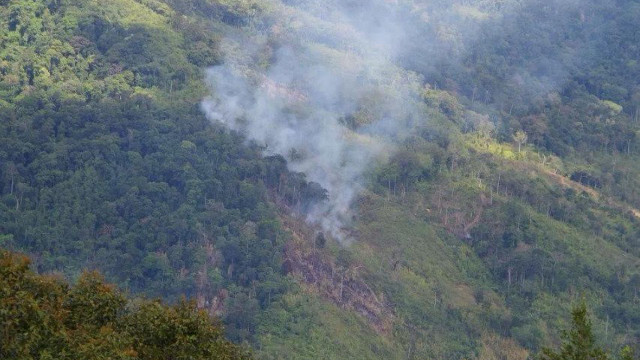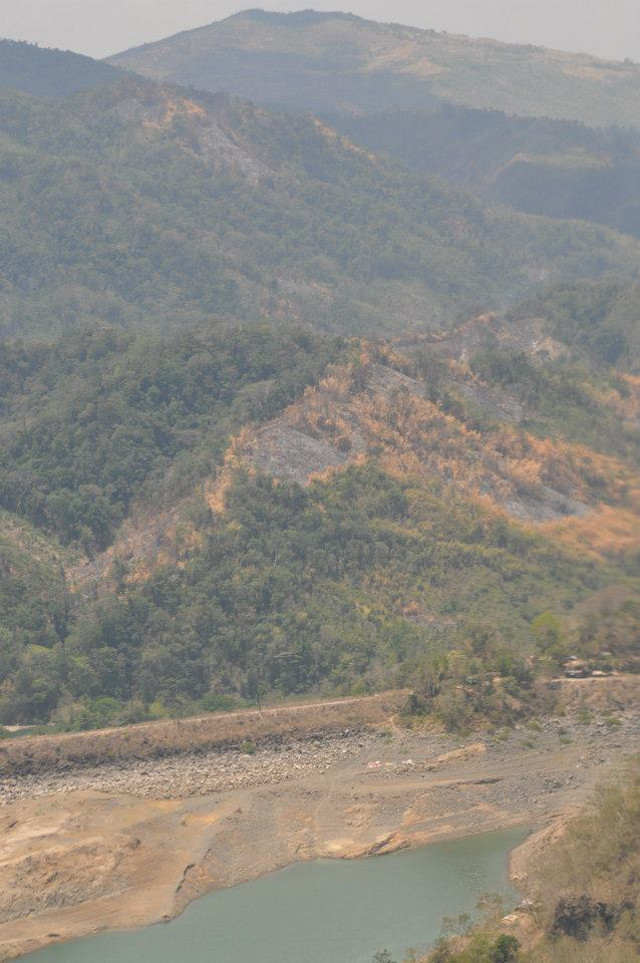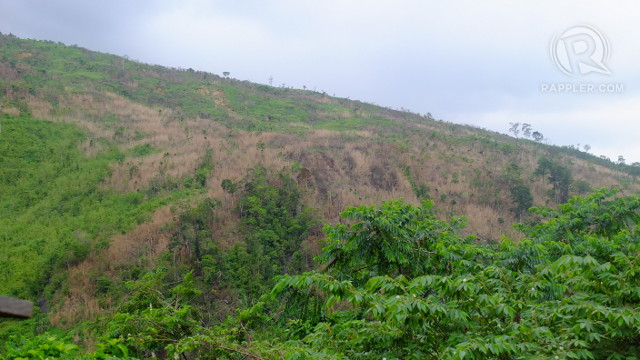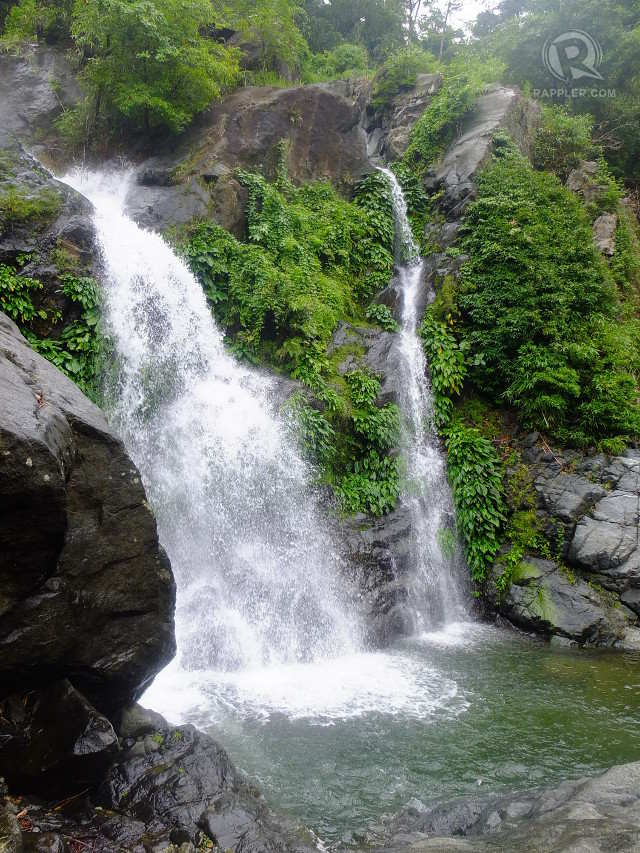SUMMARY
This is AI generated summarization, which may have errors. For context, always refer to the full article.

BULACAN, Philippines – Why do Bulacan forests continue to deteriorate despite a billion-peso government reforestation program?
Locals living inside the Ipo watershed say it is because reforestation sites there are burned deliberately year after year to allow the release of more funds into the same pockets.
The Ipo watershed in Norzgaray, Bulacan, composed of 6,600 hectares of mountain forests, has been a site for the National Greening Program (NGP) since July 2011.
In fact, it was the first NGP site and served as the “first avenue” for government employees to comply with the executive order that created the NGP.
During a visit to the watershed on June 12, Rappler saw that gmelina, kupang, and narra trees planted by the Department of Environment and Natural Resources (DENR) have grown to maturity. (READ: Is the gov’t reforestation program planting the right trees?)
But the same cannot be said of other reforestation sites in the watershed.
Some reforestation sites, including a 250-hectare site for narra, were razed last April by a massive 3-day forest fire. It came on the heels of another forest fire in March.
 These “forest fires” are a fairly common occurrence, said Edwin Santa Maria, founder of Sagip Kagubatan, a mountaineer group committed to saving the Ipo watershed. Mountaineers have many times been prohibited from continuing their climb because of such fires.
These “forest fires” are a fairly common occurrence, said Edwin Santa Maria, founder of Sagip Kagubatan, a mountaineer group committed to saving the Ipo watershed. Mountaineers have many times been prohibited from continuing their climb because of such fires.
Locals say, however, that these were not caused by the summer heat but were sparked intentionally by locals or even DENR officials and contractors who were hoping to cash in on additional reforestation funds.
“Gagawa sila ng paraan para magkaroon ulit ng reforestation. Paano sila makakapag-release ng pera para sa reforestation kung hindi masusunog ang bundok?
“Kaya tuwang-tuwa sila noong masunog. Ngayon, pinainspeksyon na naman nila, pina-evaluate. Pag nakita na ganoon, magpapalabas ng panibagong pondo sa reforestation. Ganoon lang, paulit-ulit-ulit. Taon-taon ganyan ang nangyayari,” said Lito (not his real name), an informal settler who has lived inside the watershed for more than a decade.
(They will find a way so there can be another reforestation. Or else, how will they release funds for reforestation? That’s why they are so happy when there is a fire. They will have it inspected and evaluated. When the DENR sees the burnt site, they will release new funds. This happens repeatedly. Every year, this happens.)
Money grows on trees
There is big money in reforestation. The NGP received P6.2 billion ($141.3 million) for 2014, the lion’s share of the DENR’s budget.
This budget goes to paying for seedlings (usually at P12 per seedling), people to plant the seedlings, maintenance, and survey mapping.
According to DENR Forest Management Bureau Director Ricardo Calderon, reforesting one hectare costs around P11,450 ($260).
If the government were to reforest the 60 to 70% of denuded forest in the Ipo watershed’s 6,600 hectares, it would cost more than P45 million ($1.02 million).
These funds are easy pickings for people who know how to work around the system.
There are two groups allegedly responsible for the deforestation of reforestation sites.

According to a report by the University of the Philippines (UP) Mountaineers, “reforestation drives have become a source of livelihood for some settlers. They charge a fee for their labor in assisting private groups in their reforestation activities while, at the same time, unscrupulously clearing new areas to encourage more reforestation activities.”
More than 500 families live within the watershed, said Martin Francisco, president of Sagip Sierra Madre Environmentalists Society.
Most are informal settlers who migrated from other parts of the Philippines. Others are Dumagats who have rights to 800 hectares of the watershed included in their ancestral domain.
These settlers are among the first to benefit from the NGP because they are often the ones hired to plant the seedlings.
Lito said he knows settlers who start forest fires on purpose so that reforestation efforts – their source of income – could continue.
It’s easy to get away with starting a forest fire, he said. Someone passing by a clump of trees can drop a smoldering cigarette on the ground and no one would ever know.
Dummy contractors
Some say DENR officials themselves are behind the scam.
According to Lito, some of the contracts to reforest parts of the watershed were given to a former DENR official who uses layers and layers of sub-contractors, including local people’s organizations, as dummies.
The funding is released to the sub-contractors ostensibly to support their reforestation effort, but it actually goes to the former DENR official. Once the sub-contractor “gets hot,” they are replaced with another dummy.
 “He becomes the contractor because he has a co-conspirator in the DENR NCR (National Capital Region) head office. They will talk to each other: ‘Give me the contract, I’ll look for a site,’” said Lito in Filipino.
“He becomes the contractor because he has a co-conspirator in the DENR NCR (National Capital Region) head office. They will talk to each other: ‘Give me the contract, I’ll look for a site,’” said Lito in Filipino.
In this scheme, it’s the local planters who get the worst end of the deal. The money they are paid has already been trimmed by layers and layers of subcontractors before it reaches them.
Other tales of corruption in the NGP include seedling growers and planters not getting paid at all by the president of their organization who deals directly with the DENR.
Calderon fervently denied this form of corruption in the NGP.
“There is no truth in these stories,” he told Rappler in a text message. In fact, the DENR monitors its reforestation sites to ensure the planted seedlings grow to maturity.
“All of the sites are geo-tagged and have a maintenance and protection fund. That’s why we plant high-value crops so they are not cut and are instead cared for by the communities.”
But Francisco says geo-tagging reforestation sites is not enough.
“Geo-tagging only tells you where the sites are in the map but it doesn’t give you live information on how the seedlings are doing.”
Senator Antonio Trillanes IV also raised an alarm on NGP’s lack of a monitoring system during a Senate hearing on DENR Secretary Ramon Paje’s confirmation. (READ: DENR chief grilled on reforestation program)
Commenting on the NGP’s accomplishment report, he said: “How would we actually know that this data is correct because this data also comes from your office? This may be self-serving data. If an international body conducted the survey, it would be believable.”
Forest protection needed
These reported scams and unabated illegal logging, slash-and-burn farming (kaingin) and charcoal-making in the Ipo watershed underline the need for forest protection. (READ: Illegal logging hotspots down by 84% – DENR)
“Reforestation is useless if there is no forest protection first. In our experience in the Ipo watershed, the NGP is an unregulated livelihood opportunity that only legitimizes the clearing of forests,” said Francisco in Filipino.
Lito agrees: “The solution is protection. If you close off the watershed and put forest guards, the trees will grow by themselves. The palosapis tree scatters its seeds as far as 600 to 700 meters away. If trees aren’t burned, the beauty of the forest will return.”
The destructive activities in the watershed are taking their toll.
Landslides along the river have become more common, dumping soil into the river and causing siltation.
The Ipo River shrinks more and more every dry season because the loss of trees has reduced the watershed’s ability to absorb and generate water.
In a time when the country is expecting an El Niño, Metro Manila cannot afford to lose a watershed.
Ipo watershed generates water for the Ipo River which feeds the Ipo Dam and La Mesa Dam, vital sources of water for the megacity.
The NGP aims to plant 1.5 billion trees over 1.5 million hectares until 2016. – Rappler.com
Add a comment
How does this make you feel?
There are no comments yet. Add your comment to start the conversation.